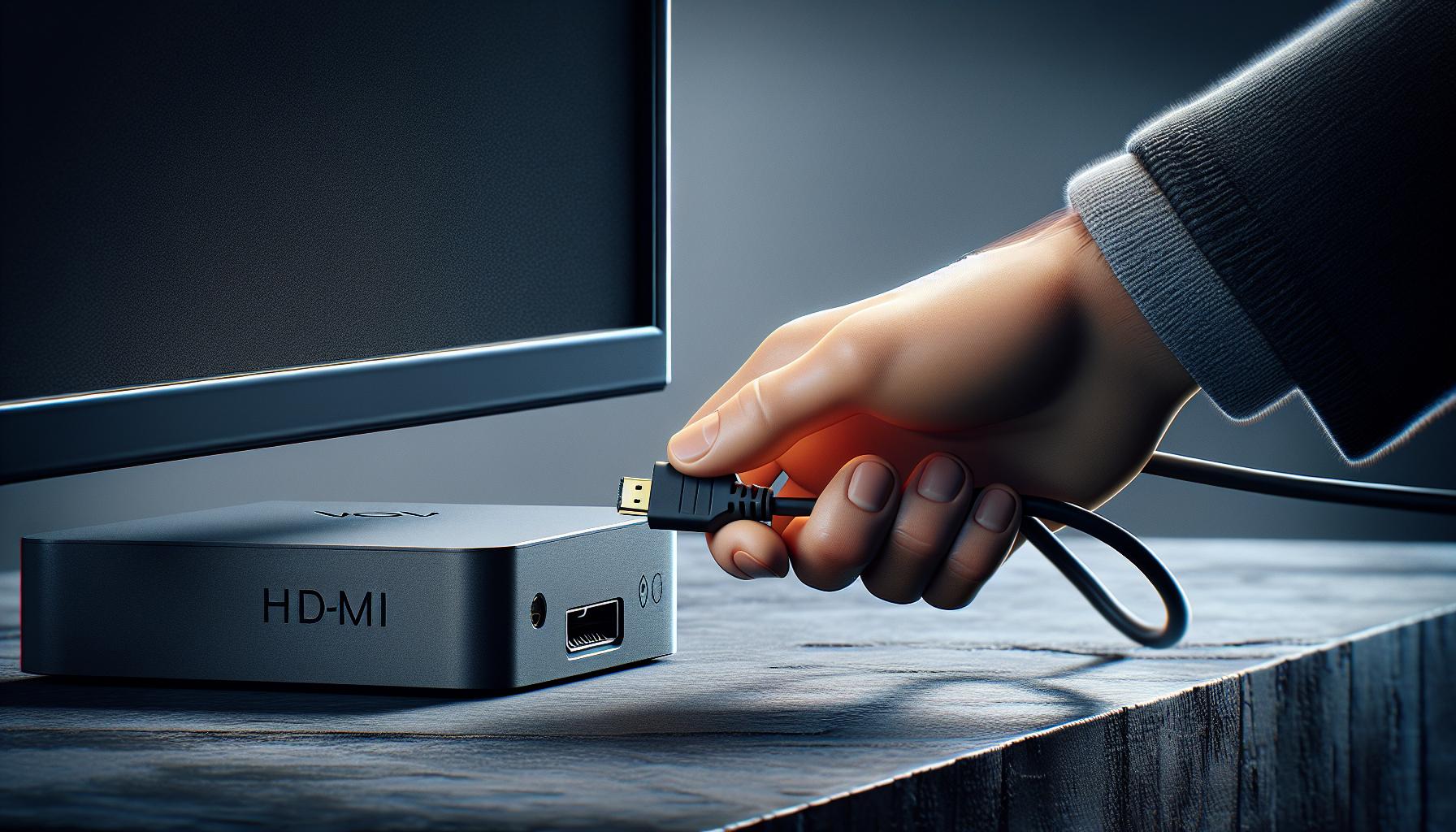Ever wondered how to make your Apple TV remote turn on your TV? You're not alone. It's a common question among Apple TV users and we're here to help you out. With just a few simple steps, you'll be able to control your TV with your Apple TV remote in no time.
The beauty of the Apple ecosystem lies in its seamless integration, and the Apple TV remote is no exception. It's designed to not only control your Apple TV but also your television set. This means less clutter and more convenience for you. So, let's dive in and get your Apple TV remote turning on your TV.
Step 1: Check compatibility between your Apple TV and TV
Understanding Compatibility
Before you dive into the settings and potential solutions, it's crucial for you to consider one vital fact: Not all TVs are created equal. That's right, your TV's brand, model, and even its year of manufacture can significantly impact its compatibility with Apple TV.
So, how do you figure this out? It's pretty straightforward. Simply check out your TV's specifications and see if they align with the Apple TV's requirements. You can usually find this information in your TV's user manual or on the manufacturer's website. Keep in mind, your Apple TV needs a TV with an HDMI port to function correctly.
Checking Your Remote's Compatibility
Let's talk about the Apple TV remote itself. You might love its sleek design and sophisticated touch interface. But did you know that its compatibility can differ based on the model?
Here are the primary Apple TV remote models:
- Siri Remote
- Apple TV Remote
- Apple Remote (aluminum or white)
As a rule of thumb, you should know that the Siri Remote and the Apple TV Remote work with the 4th generation Apple TV and later, as well as the Apple TV HD. On the other hand, the older Apple Remote (both the aluminum and white versions) are compatible with earlier versions of Apple TV.
Just take note that functionality can vary based on your remote and Apple TV model pairing. It's always best to consult your Apple device's user guide and confirm.
Once you've ensured that your Apple TV, remote, and TV are all compatible, you're all set to move to the next step – configuring your settings.
Keep in mind that this step is fundamental to making your Apple TV remote turn on your TV. So, ensuring compatibility shouldn't be skipped. After all, it could save you lots of time and eliminate unnecessary troubleshooting down the line.
While ensuring compatibility might initially seem like a bit of a task, remember it's all about enhancing your convenience and creating a seamless viewing experience. Let's keep moving forward with the process.
Step 2: Connect your Apple TV to your TV

Once you've confirmed that your TV, Apple TV, and remote are compatible, it's time to move onto the next step - connecting your Apple TV to your TV. This process may seem complicated but don't worry, it's actually pretty straightforward.
Start with your Apple TV. Ensure it's unplugged before you begin the setup process. Now, locate the HDMI port on your Apple TV. This is where you'll connect the HDMI cable. Plug one end of the HDMI cable into this port. Remember HDMI is the key to a successful connection!
On your TV, locate the corresponding HDMI slot. Typically, it's on the back or side of your TV. Simply attach the other end of the HDMI cable to this port. Remember, if your TV has multiple HDMI slots, take note of the slot number where your HDMI cord is attached. This will make input selection easier later on.
Then, move on to plug in your Apple TV into a power outlet. Use the provided power cable in the Apple TV package. On observing a blinking light on your Apple TV, you've successfully connected it to a power source.
The next step is setting up the Wi-Fi. Navigate to Settings, then Network, find out your Wi-Fi from the list, and enter your Wi-Fi password.
That's it! You've successfully connected your Apple TV to your TV. In the next section, we will cover how to pair your Apple TV remote and control your TV.
Step 3: Set up the Apple TV remote to control your TV
Now that you've powered on your Apple TV and it's connected to the Wi-Fi, it's time to pair the remote. This step is an essential part of your Apple TV setup. After all, without a paired remote, controlling your TV through the Apple TV could be challenging.
The first thing you'll want to do is make sure the remote has batteries. Don't overlook this - nothing can be more frustrating than trying to pair a remote with no juice. So, if the remote isn't responding or if it's been dormant for a while, it might be a good idea to pop in a new set of batteries.
Once you've ensured the Apple TV remote has power, pick it up and point it towards the TV. If your Apple TV was off, it should wake up. An onscreen guide will then step you through the pairing process. Follow the instructions on the screen - they're simple and easy. In no time, you'll have your Apple TV remote synced and ready to use!
After successfully pairing your remote, you're almost done. The next essential step to using your Apple remote to turn on the TV is setting up the remote to control the TV. This process will allow you to adjust your TV's volume, switch inputs, and power on and off the TV using the Apple TV remote.
To do this, go to 'Settings' on the Apple TV Home screen. Select 'Remote and Devices', then 'Volume Control'. Choose 'Learn New Device', and follow the on-screen steps. After finishing the process, your Apple TV remote should be able to control these functions on your TV.
In the next section, you'll discover how to optimize your Apple TV settings for the ideal viewing experience. However, remember that if you ever encounter difficulties during setup or use, don't hesitate to seek help. The Apple community is quite active, with several forums and help centers online catering to every type of user query. Get that remote set-up and dive right into an immersive viewing experience that only Apple TV can truly offer.
Step 4: Test the Apple TV remote functionality on your TV
Right after setting up and pairing your Apple TV remote, it's pivotal to check its proper functioning with your TV.
Having done the legwork, now's the time to ensure that all your efforts weren't in vain. Are the remote's buttons responsive? Does the volume increase or decrease with a press, and does the TV power on and off as intended?
First off, ensure your Apple TV is powered on. Press the Menu button or the Home button depending on your remote model. You ought to see the Apple TV display on your TV. If not, you might need to select the Apple TV input using your TV's remote.
Attempt switching your TV on and off using the Apple TV remote. If you've correctly followed previous steps, your television should react to the commands. Repeat the process for volume control; ensure your TV responds when you adjust the volume upward or downward.
Having problems? Don't fret. It might be an indication of a simple issue like low battery levels. Check if your remote needs to recharge or requires new batteries altogether.
If the issue persists despite replacing the batteries, unplug your Apple TV, leave it idle for about a minute, and reconnect it. Once the Apple TV has rebooted, try using the remote again.
Suppose that your Apple TV remote still isn't functioning correctly, you might need additional help. Explore support forums, use the Apple Support website, or reach out to Apple's customer service.
Don't rush to conclude that your Apple TV remote is defective. It's not uncommon to encounter operation hitches or minor issues in the initial stages of familiarization. With patience and a little troubleshooting, you'll be swiftly navigating your Apple TV in no time.
Do keep track of your progress. It's an effective way to understand the remote's versatility, and you'll soon be maneuvering through various applications and functions with ease. Keep tweaking, testing, and optimizing your remote settings until you're satisfied. And remember, it's all about improving your overall viewing experience.
Step 5: Troubleshooting tips if the Apple TV remote doesn't turn on your TV

If you're finding that your Apple TV remote isn't turning on your TV, don't worry just yet! There are a few steps you can take to attempt a solution, and they're not as complex as you might think.
First off, when your TV fails to power on using the Apple TV remote, check the battery level of the remote. Remember, it's the first thing you need to do whenever you experience issue with electronic devices. You can check the battery level by navigating to 'Settings', then 'Remotes and Devices', and finally, 'Remote'. If you find the battery is low, replace them and try turning on the TV again.
Sometimes, it could be that the remote needs to be reset. To do is, press and hold the Menu button and the Volume Up button simultaneously until your Apple TV status light blinks rapidly. Then release the buttons and try to turn on the TV. This might work if the issue was just a small technical glitch.
If the above steps don't work, it's time to reset your Apple TV altogether. While the process may seem a bit daunting, it's actually quite simple:
- Disconnect the power cord from your Apple TV
- Wait for about 1 minute, then reconnect the power cord
- Wait for Apple TV to restart. This could take some time, so don't rush it.
After the restart, try using the remote again to see if the problem has been resolved.
Lastly, in rare cases, there might be an issue with the compatibility between your TV set and the Apple TV remote. If none of the aforementioned steps work, it might be worth contacting either Apple's support services, or the team behind your specific TV model.
Remember, everyone encounters technological issues occasionally. It's nothing to get stressed about. Just patiently try each step we've outlined until you find the solution that works for you. The key is to keep calm, read the instructions carefully, and remember that help is always just a call away. If all else fails, you won't be left stranded; Apple's tech support professionals are known for their helpfulness and expertise.
Conclusion
So, you've got the knowledge now to tackle that pesky problem of your Apple TV remote not turning on the TV. Remember, start with the basics like checking and replacing batteries. If that doesn't cut it, don't hesitate to reset the remote or even the Apple TV itself. And remember, compatibility issues can crop up, so reaching out to Apple's support services or your TV manufacturer isn't a bad idea. Patience is key here. Keep trying each step until you find the one that works for you. And don't forget, Apple's tech support is always there to lend a hand. You've got this!
1. What do I do if my Apple TV remote doesn't turn on my TV?
First, check the battery level of your remote. Replace the batteries if necessary to ensure adequate power.
2. What if changing the batteries doesn’t help?
Try resetting your remote. You can do this by pressing and holding the Menu button and Volume Up button at the same time.
3. How can I reset the Apple TV?
Disconnect and then reconnect the power cord to reset your Apple TV.
4. What if the remote and my TV have compatibility issues?
In the event of compatibility issues, try reaching out to Apple’s support services or your TV manufacturer for further guidance.
5. Where else can I get help?
Always remember, Apple's tech support professionals are available to assist with any ongoing issues. You are encouraged to contact them if your problem persists.




